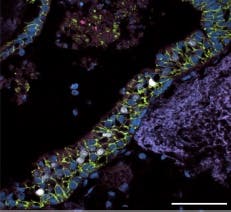
Stem cells were coaxed to grow into 3D dimensional mini lungs, or organoids, for the first time. These survived for more than 100 days. These pioneering efforts will serve to deepen our understanding of how lungs grow, as well as prove very useful for testing new drugs’ responses to human tissue. Hopefully, once human tissue grown in the lab becomes closer and close to the real deal (cultured hearts, lungs, kidneys etc.), animal testing might become a thing of the past.
Previously, lung tissue was only grown in flat (2D) cell systems, basically on thin layers of cell cultures. Some 3D structures had also been developed by scientists, but these were made onto scaffolds from donated organs which had their cells removed. Of course, the organoids grown at the University of Michigan Medical School aren’t what you or me know as lungs. Since these were grown in a dish, the cells lack vital components like blood vessels, which facilitate the gas exchange during breathing. Nevertheless, components like large airways known as bronchi and small lung sacs called alveoli were successfully grown. These 3-D structures are the closest we’ve come to a lab grown lung, according to the paper published in eLife.
To make the lung organoids, the team manipulated signaling pathways that control the formation of organs.
- Stem cells were instructed to form a type of tissue called endoderm, found in early embryos and that gives rise to the lung, liver and several other internal organs.
- Scientists activated important development pathways that are known to make endoderm form three-dimensional tissue while inhibiting two other key development pathways at the same time.
-

Acellular human lung matrix was seeded with spheroids and cultured for 40 days. Resulting matrices had abundant proximal airway-like structures (scale bar 10 μM) (credit: Briana R. Dye et al./eLife) The endoderm became tissue that resembles the early lung found in embryos.
- This early lung-like tissue spontaneously formed three-dimensional spherical structures as it developed.
- To make these structures expand and develop into lung tissue, the team exposed the cells to additional proteins that are involved in lung development.
- The resulting lung organoids survived in the lab for more than 100 days.
“These mini lungs can mimic the responses of real tissues and will be a good model to study how organs form, change with disease, and how they might respond to new drugs,” says senior study author Jason R. Spence, Ph.D., assistant professor ofinternal medicine and cell and developmental biology at the University of Michigan Medical School.
“We expected different cells types to form, but their organization into structures resembling human airways was a very exciting result,” says lead study author Briana Dye, a graduate student in the U-M Department of Cell and Developmental Biology.



